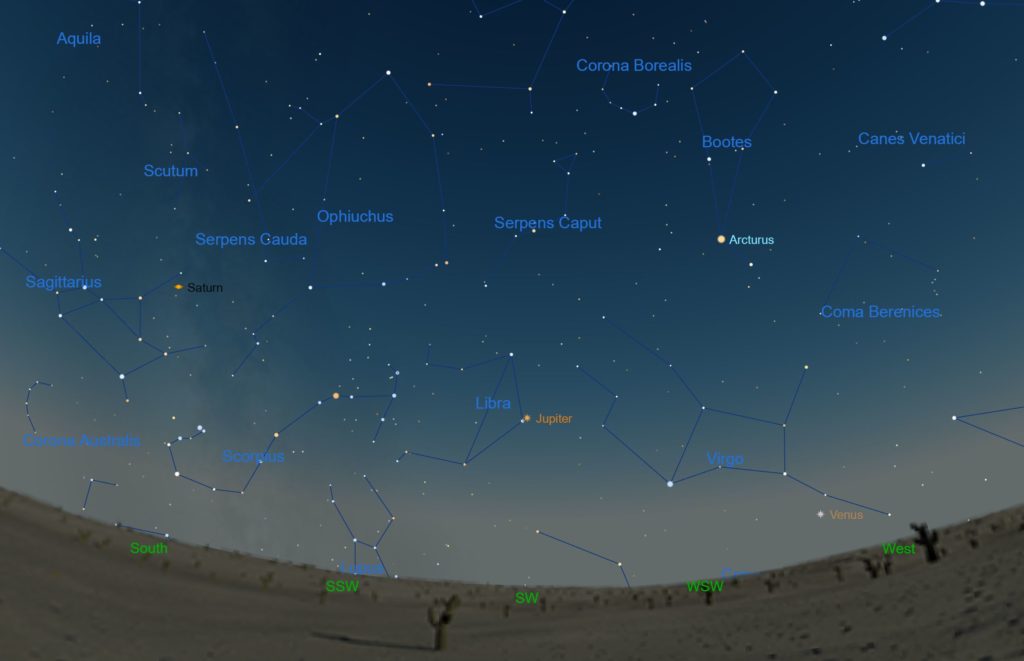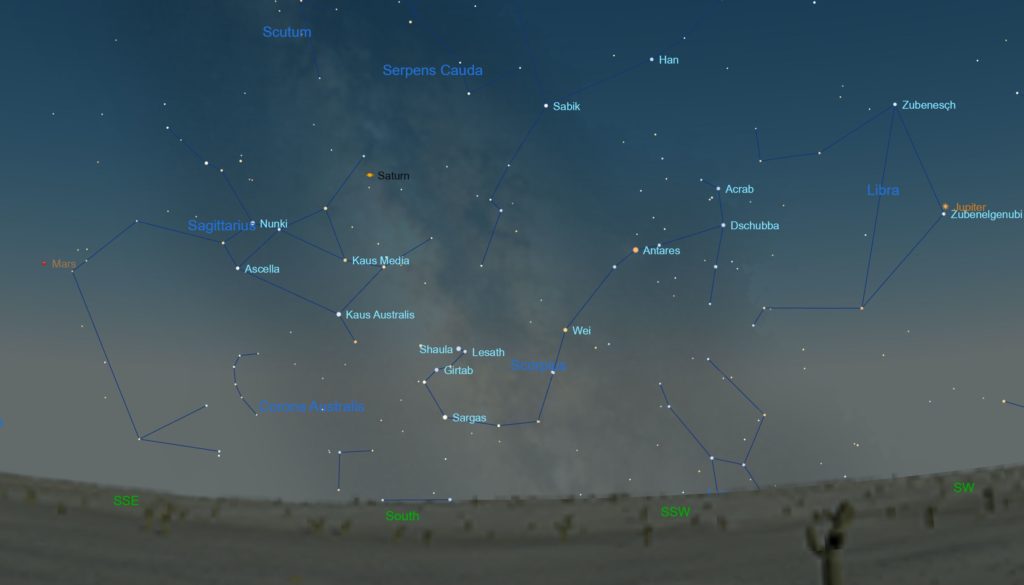
August is arguably the best month for stargazing. For northern-hemisphere observers, the weather is still warm but much of the unsettled and humid summer air dissipates and skies become, on average, drier and clearer. Observers in the southern hemisphere enjoy warmer weather as winter nears an end, and the center of the Milky Way, the starriest part of the night sky, still lies just past overhead. And of course, the Perseid meteor shower peaks this month, and the Moon will stay mercifully out of the way for this event this year. There are also plenty of planets to see in the evening sky, including Mars, which has just passed opposition and still shines brightly all month. Jupiter and Saturn remain large enough to afford good views with a telescope. And Venus slowly brightens in the western sky after sunset. Here’s what’s going on in the night sky this month.
1-31 August. Planets, planets everywhere! Look to the west and south after sunset to take in four dazzling planets. From right to left, look for Venus (the brightest), very bright Jupiter, Saturn, and brilliant red-orange Mars. These planets will remain in the sky all month. With your unaided eyes, binoculars, or a telescope, all these planets are a beautiful sight. And here’s some welcome news… the planet-wide dust storm on Mars is finally dying down, so hopefully we can all get a better view of the surface of the Red Planet.

4 August. Last Quarter Moon, 18:18 UT
6 August. The Moon is on its way out for the month in the eastern sky before sunrise. It hovers near the Hyades star cluster in the constellation Taurus.
6 August. Jupiter reaches quadrature at a point in the sky 90º east of the Sun. The planet reached opposition in early May. During August, it continues to shrink from about 38” to 35” and dim from magnitude -2.1 to -1.9. The king of planets suffers a rare indignity: it’s outshone all month by the planet Mars. But Jupiter is still a fine sight in binoculars or a telescope. Wait for a night of good seeing and go observe the ever-changing weather patterns on this magnificent gas giant.
11 August. New Moon, 09:58 UT
11 August. A partial solar eclipse is visible over the extreme northern reaches of Europe, Canada, Greenland, and Asia. Only 10% to 20% of the Sun is eclipsed from Scandinavia, while more of the Sun is covered in more northerly regions. The point of greatest eclipse, where more than 65% of the Sun will be covered, lies near the North Pole. If you’re in the area, enjoy the view and bring a camera and a safe solar filter. See the map of where the eclipse will occur at this link.

12 August. The Perseid meteor shower peaks in the early-morning hours of August 12-13. This is the finest meteor shower of the year for northern stargazers, with 40-60 meteors per hour visible at the peak in the hours before dawn on August 13. The Moon is just a waxing sliver during the peak this year, which means you will have a spectacular view of the event if you can find clear and dark sky. Once called the Tears of St. Lawrence, this meteor shower occurs as the Earth moves through a stream of debris left by Comet Swift-Tuttle. You will see Perseids from late July until mid August, but the peak generally occurs on August 12-13.
14 August. Venus is joined by a thin crescent Moon in the western sky after sunset. The two celestial bodies are about three finger-widths apart, and between them lies the closely-spaced double star Porrima (Gamma Virginis).
16 August. Jupiter lies just a Moon’s-width north of the 2nd-magnitude star Alpha Libris. The waning crescent Moon is nearby.
17 August. Venus reaches greatest eastern elongation about 46º from the Sun. The planet will now slowly appear to move back towards the Sun for the next several months. The planet grows brighter, from magnitude -4.3 to a very impressive -4.7, and grows from 20” to 29”. It also changes from just past half lit to about 40% illuminated. Well worth a look through a telescope!
18 August. First Quarter Moon, 07:48 UT
23 August. Mars is just on the edge of the boundary between Sagittarius and Capricorn in the southeastern sky an hour or two after sunset. The planet is amazingly bright this month, though it slowly fades from magnitude -2.8 to -2.2 at the end of the month and shrinks from 24” to 21”. The planet has just passed its best opposition since 2013, so if you have the weather and the means, go observe the surface of this still-mysterious world. The Cosmic Pursuits guide to observing the planet Mars will help you get a good view and identify the features you see.

20 August. The Moon passes about 4º north of yet another planet, Saturn, in the constellation Sagittarius. Saturn reached opposition in late June and the planet slowly shrinks and fades this month. But its disk is still about 18” across and its rings are still dramatically tilted by about 26º. The planet is located above the ‘Teapot’ of Sagittarius. If you have a telescope, go see it!
26 August. Full Moon, 11:56 UT
31 August. Look for Venus just a finger-width away from the 1st magnitude star Spica (Alpha Virginis) in the western sky after sunset.